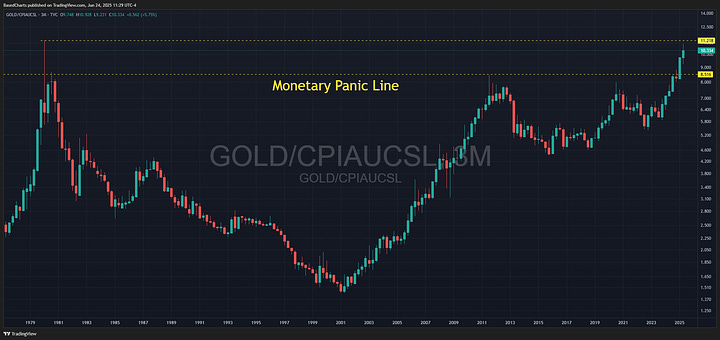Charting is simply pattern-recognition. Human beings behave in predictable ways. Chart setups tell us people are behaving similarly to existing patterns. In some cases, successful and failed patterns are equally useful because they’re reflective of indecision. Breaking out of this condition results in substantial moves.
Crude has a large consolidation pattern. The target goes as low as the $20s on a pure chart read, with the $40s being a more conservative target.

Break up and it’s 2022 redux. CPI readings go up, consumers retrench, probably a stagflationary recession unfolds.
However, macro factors are bending the other way. China’s 10-year yield is plumbing modern lows. Demographics across the developed and developing world are terrible outside of Africa and some Muslims countries. Many petro-states are running deficits that will require more oil production in the event of falling prices. Through budget mismanagement or aggressive development policies, they have put themselves in a situation similar to indebted U.S. producers.
I asked ChatGPT to do a rundown of oil demand and potential scenarios for peak oil.
A peak in oil prices would “front run” a peak in oil demand. Only after the subsequent expansion phase would we realize that peak oil was already hit. The template is the 2020 lockdowns, where oil takes off amid stimulus and potentially spikes on geopolitical risk. Real demand and inflation would be intertwined. As happened coming out of various slowdowns all the way back to the 2007 peak, “the market” will be overly optimistic about growth and only in hindsight recognize the reality.
Voter-Imposed Decline of Some Sort
Coming out of the Black Plague there was a deflationary boom as wealth soared. More resources spread among fewer people. The modern world unleashed something like a slow-motion plague of low fertility.
In some countries, anti-growth parties such as Greens in Germany are accelerating collapse, while other political forces subconsciously marry a suicidal impulse with pure greed. Open borders is a self-destructive policy that is likely coming to an end. Canada’s open borders policy is already turning per capita GDP growth negative.
The political choice in NYC today, in the city’s Democratic primary for Mayor, is between old-school Democrat Cuomo and an immigrant communist who leads in the polls. It’s expected the winner of the primary will win the general election.
The inflation-adjusted price of copper is about 40 percent of its peak. Its adjusted-peak is $8 per pound based on the most recent CPI. There’s plenty of room for an inflationary price phase that fails to reach a new real high.
The voters have had enough of falling living standards as a tradeoff for goal-seeking headline GDP. Governments will either allow real, emission increasing growth via whatever form of energy does the best job or they will choose the path of managed decline while maximizing living standards. Thus, there are bullish scenarios for commodities on the table longer-term, but the emerging signs point to a cyclical downturn.
Gold
If commodity prices fall, then investors don’t need inflation protection. Gold is still sporting a monthly topping signal, but could close June with a third topping wick.
It last did something similar in April-June 2024 before breaking out. More often it has been a bearish signal. Gold is also sitting at an inflation-adjusted peak. Anti-dollar, inflation memes are everywhere. “Nothing stops this train” is a common refrain. the investment corollary is “throw cautious to the wind.” Investors who believe the dollar is doomed will pay any price for gold, crypto or other assets they believe will shelter them from the storm.


The risk isn’t so much that they’re wrong. History says they could be proven correct in the end.
It’s more the timing. When charts take on a hyperbolic curve, it’s evidence of extremism, bullish or bearish. Outside of actual hyperinflations such as in Argentina which have fundamental sources, an investment extreme usually coincides with a sentiment extreme. If the future is different from expectations, prices can violently collapse.
Best case for gold here is not from the dollar. It’s rapid depreciation in the yuan, yen or euro. The dollar bears are “all-in” on gold and BTC already, but it doesn’t look like a hyperinflationary setup. The 12-month change in crude points to the direction of core CPI.
If crude rises, inflation and CPI turns up. If crude breaks below $55 per barrel, CPI is going back to the Fed’s target.
Short-term, a pullback in gold would likely end at channel support, about 11 percent lower. It would still be inside a very steep uptrend at that point. A more serious pullback in gold will result in a decisive break below $3000 per ounce.
Equities
The asset class most in line for a negative rebalancing is equities. Socialists will tax away gains and populists will implement pro-labor policies that shrink margins.
Short-term though, equities benefit from Trump tacking new problems onto the Wall of Worry.
NDX is about 100 points off its all-time high following the Tariff Tantrum and then War Worry.
Tumbling oil means lower inflation, which allows for lower interest rates. Equity markets are not going to focus on long-term valuations until there is quiet. Churning and burning of short-term bulls and bears keeps the focus on immediate issues.
It’s like playing fetch with a retriever.
The market drops because it wildly overreacts to news. It overreacts in part because it’s rational to overreact when the starting point is valuations on par with September 1929 and March 2000. However, both tariffs and war drums were wildly overhyped, with terrible analysis in the mainstream, thus creating a bullish condition as these worst-case forecasts were obliterated by reality.
On June 13, I wrote:
At every turn, it has paid to short oil on geopolitical concerns out of the Middle East, with the caveat that each of the spikes marked a peak in terms of shock.
What was the peak shocking moment of this episode? The USA bombing Iran’s nuclear sites on Saturday, June 21. When did oil peak? First chance it got, at the futures open on Sunday night.
How high could the market go in a melt-up? I don’t know that NDX 30,000 isn’t out of the question.
Tim Knight of Slope of Hope just posted this ARKK/QQQ ratio:
Cathie’s Top 10 is straight out of YOLO world. If ARKK is beating QQQ, then my guess is QQQ is also going up like a rocket. NDX 30,000 by September seems unlikely, but easily doable by next March.
There are all manner of bullish theories for the market blowing out valuations, but look at the fundamentals.
Real GDP growth since 2007 is 1.85 percent.
Population growth averaged 0.81 percent over these years.
Real GDP is increasing about 1 percent per year.
To the extent the market looks exponential, it’s because the corporate sector is taking a larger and larger slice of the economy. The only way to sustain this trend is for techno-fascism. Jobs are permanently destroyed and people are put onto permanent welfare programs. The trouble with this scenario is that China is the country best positioned to implement it because they produce goods at low cost.
China isn’t growing much either though. Why would they, when the number of consumers is shrinking? China’s population growth will start cutting even more deeply into real GDP soon.
Occam’s Razor says the market has never been this divorced from reality. Dystopian political futures await if these trends aren’t fantasy, and don’t break. Disaster potentially of similar scale to the 1930s, certainly the 2000s tech bear, will unfold in equities if this is a delusion bubble.
Elsewhere
MAE mentioned last week, hit resistance and pulled back. Share consolidation and moving towards production should help it outperform if the bull market holds. Best case scenario here is the market treats it like everything else in a gold sell-off. Junior miners with no income implode in bear moves because of dilution. It creates a spiraling decline because as the price falls, the company must dilute more and more for a given cash need. Maybe the market will throw investors a bone here. Keep it on your radar.
SAU broke out, but may be done here as well.
Stocks left for dead have often popped at the end of a speculative run. Smaller, retail investors are a larger share of microcap stocks. If stocks like this aren’t topping out, stagflationary forecasts deserve another look. That won’t be bullish for SPX and NDX.
Some more speculative miners after the jump.





















